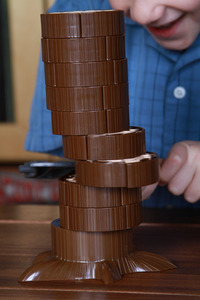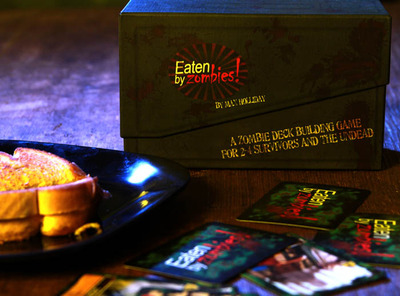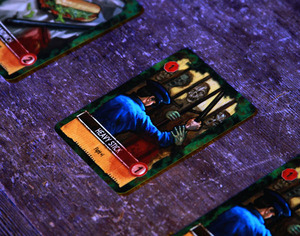Toc Toc Woodman - A Dexterity Game Review
 Saturday, January 28, 2012 at 11:59PM
Saturday, January 28, 2012 at 11:59PM 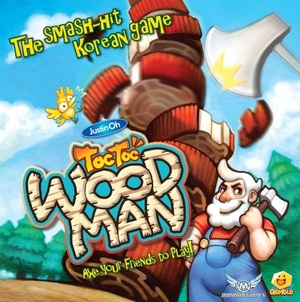
Mayday Games is best known for it's line of card sleeves for the hobby game market, but has recently jumped into the game publishing market with a nice selection of original and reprinted games. One of these games is a quirky Korean import called Toc Toc Woodman, designed by Justin Oh. Toc Toc Woodman is a dexterity game that tasks players with using a plastic axe to chop the bark from a large plastic tree without causing the tree to collapse. On the surface, it may sound similar to other popular dexterity games like Jenga, but make no mistakes, this Woodman has a whimsical style like no other.
Components:
The components in Toc Toc Woodman are made from a sturdy, lightweight, molded plastic that is built to withstand the repeated hits from the small plastic axe used during gameplay. Included in the game is a small plastic base upon which the rest of the pieces are stacked to form "slices" in the trunk of a small tree. Each slice has a central, lightly colored "core" with four brown pieces of "bark" that slide into it. Although quite simple in construction, it is surprising the way these components interact with each other to create a structure that is both strong and precarious at the same time.
Gameplay:
Toc Toc Woodman's rules are easily described in just a few sentences. In fact, although printed rules are included, a player can simply read the large lettering on the back of the box, and know everyth ing he needs to play. During the game, players take turns hitting the segmented tree trunk with a plastic axe, trying to knock the bark off of the center core. While this may sound simple, it is usually easier said than done; as players hit the tree, the different stacked segments will be pushed around, causing the pieces of tree trunk to shift their balance. If a player is skillful, he will only knock the brown bark off of the tree, but a misjudged strike can cause one of the center cores to fall - or worse, the entire tree to collapse. For every piece of bark knocked off, the player scores a point, but, if one of the core pieces is knocked down, the player loses 5 points. Each player must take two hits before the next player gets a chance to wield the axe. When all of the bark has been knocked from the tree, the player with the most points wins. More times than not, however, the game actually ends when the entire tree comes crashing down due to a misjudged chop - which can be very cathartic for the other players when it's the lead player doing the chopping.
ing he needs to play. During the game, players take turns hitting the segmented tree trunk with a plastic axe, trying to knock the bark off of the center core. While this may sound simple, it is usually easier said than done; as players hit the tree, the different stacked segments will be pushed around, causing the pieces of tree trunk to shift their balance. If a player is skillful, he will only knock the brown bark off of the tree, but a misjudged strike can cause one of the center cores to fall - or worse, the entire tree to collapse. For every piece of bark knocked off, the player scores a point, but, if one of the core pieces is knocked down, the player loses 5 points. Each player must take two hits before the next player gets a chance to wield the axe. When all of the bark has been knocked from the tree, the player with the most points wins. More times than not, however, the game actually ends when the entire tree comes crashing down due to a misjudged chop - which can be very cathartic for the other players when it's the lead player doing the chopping.
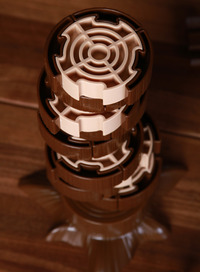 That's really all there is to the game. It plays very quickly, and often times, the setup takes longer than the game itself. There are a couple of gameplay variants printed in the manual, and while these add some variety, there is an enjoyable simplicity in the basic game that I prefer.
That's really all there is to the game. It plays very quickly, and often times, the setup takes longer than the game itself. There are a couple of gameplay variants printed in the manual, and while these add some variety, there is an enjoyable simplicity in the basic game that I prefer.
Conclusion:
Even with the short play time and simple rules, there is a lot of fun to be had in this quirky game. The tension of the barely-balanced tree elicits gasps around my table, and giddy cackling from the children when one of their siblings, or, heaven forbid, one of their parents has caused the entire structure to collapse. In fact, this is one of those elusive games that can be enjoyed by adults and children alike, and more importantly - together. The nature of tapping the plastic trunk with a small "toc, toc" doesn't require the same extended control of small motor skills that a game like Jenga does, which is a great equalizer when it comes to younger folk. Players only need to decide where to hit and how hard, which actually makes To c Toc Woodman as much of a press-your-luck type game as it is a dexterity game. Hitting the tree hard can knock a lot of bark off, but there is a high probability that disaster will strike. On the other hand, a player who is too timid with his strength can come away empty handed. When many games I play with my kids can be mind-numbingly boring in their simplicity, it's refreshing that Woodman is able to take very basic rules and deliver something that is actually fun.
c Toc Woodman as much of a press-your-luck type game as it is a dexterity game. Hitting the tree hard can knock a lot of bark off, but there is a high probability that disaster will strike. On the other hand, a player who is too timid with his strength can come away empty handed. When many games I play with my kids can be mind-numbingly boring in their simplicity, it's refreshing that Woodman is able to take very basic rules and deliver something that is actually fun.
Although I have had great success playing Toc Toc with my children, it's important to note that it isn't just a kids game. The fun of being a miniature lumberjack is universal, so even when there are no kids in sight, Toc Toc is still a great experience with the right crowd. Toc Toc Woodman isn't going to be winning any awards for deep strategy, but as a quick social game to play with family or friends, it works exceedingly well. Where children love the simple rules and the inherent destruction of watching the tree collapse, adults 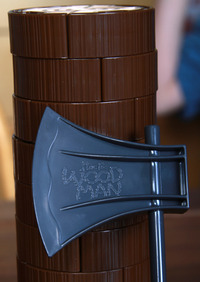 will love the quirky theme... and the inherent destruction of watching the tree collapse.
will love the quirky theme... and the inherent destruction of watching the tree collapse.
The only negative thing I really have to say about Woodman, is that the 45 seconds it takes to set the game up can sometimes seem disproportionately long; especially when the game can take as little as 2 minutes to play. But then again, it ONLY takes 45 seconds to set up, which is arguably faster than any other game in my collection.
When deciding if you should purchase Toc Toc Woodman, there are a couple of angles to consider: For adult gamers, Toc Toc is firmly entrenched in the silly-fun filler game category, and will find success in a lively game group that enjoys the occasional light game... and perhaps the occasional cocktail. For parents with young children, though, Toc Toc Woodman makes for a great opportunity to bring the family to the table, and offers a chance to truly enjoy the smiles and laughter that gaming with kids delivers - and for me, this is where Toc Toc Woodman really shines.
 Board Game,
Board Game,  Justin Oh,
Justin Oh,  Mayday Games,
Mayday Games,  Toc Toc Woodman,
Toc Toc Woodman,  review in
review in  Board Games
Board Games 
